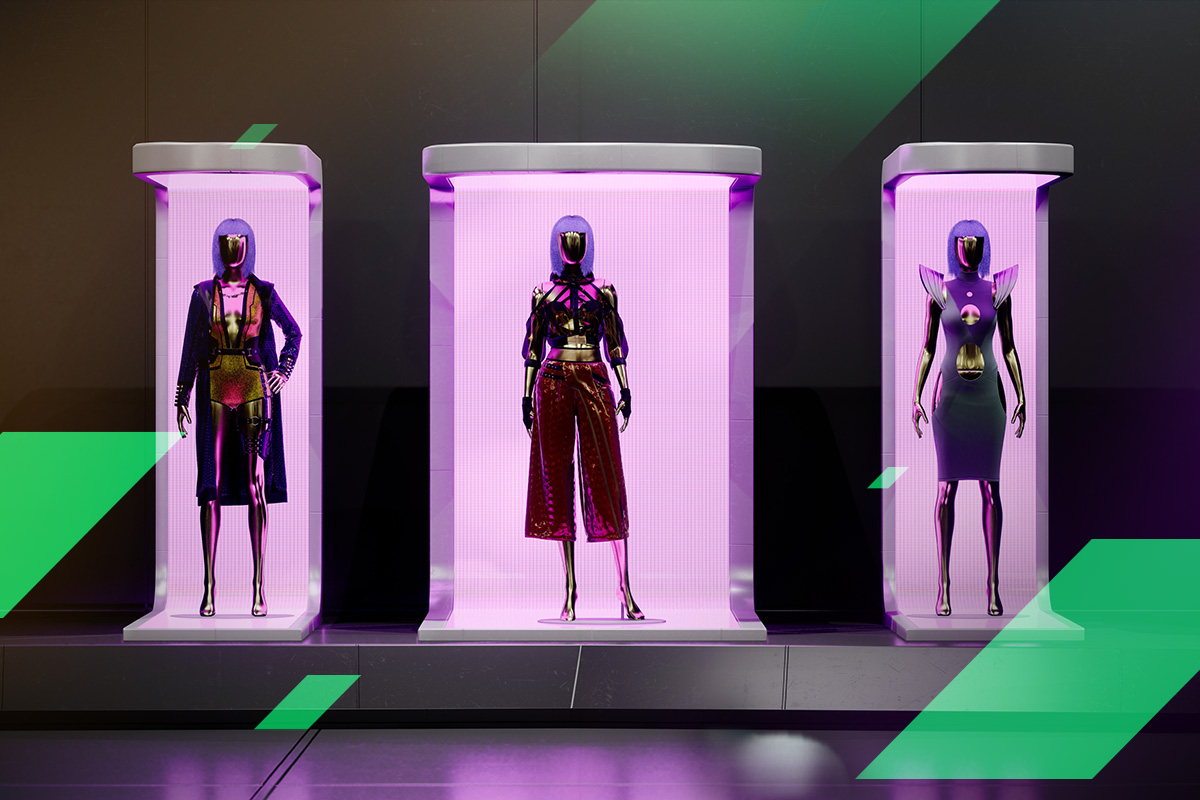Get the look: luxury fashion brands strut their stuff in the metaverse

'Style over substance' is a tag often applied to the cyberpunk subculture from which the idea of the virtual reality metaverse evolved. Fashion isn't the first thing that one might associate with the heavily computer-literate core crypto community, but a quick look at the relevant media will quickly disprove this. From the iconic slick sunglasses-and-trench coat attire of The Matrix to the unique outfit combinations of NFT collections such as Bored Apes, the message is clear: what's the point of having a metaverse avatar if you can't look really, really cool?
The popularity of skins and cosmetic items in video games already proves that consumers are willing to drop serious cash on digital outfits. And just like in real life, people like to have their digital avatars decked out in their favourite fashion brands.
High-tech fashion
The digital territories of the metaverse are already hosting forward-thinking fashion brands in the form of online events. One such event was the first-ever Metaverse Fashion Week, which pulled an impressive string of fashion industry A-list brands, such as Etro, Tommy Hilfiger, Perry Ellis, Dolce & Gabbana, Elie Saab, Hogan, Dundas, Imitation of Christ, Nicholas Kirkwood and Estée Lauder.
Over in the real world, brands like Philipp Plein, Gucci, Off-White and Balenciaga can be bought with certain cryptocurrencies, and cyber aesthetics, like hi-tech glasses, chunky shoes and Matrix-inspired hacker chic, have returned to catwalk collections.
Copyright, Controversy and Competition
Web3 is coming; it's just a question of exactly when. With the metaverse gradually growing, the pressure is on brands to get ahead and establish their presence or risk getting blindsided by independent creators. Take, for example, the recent controversy between digital artist Mason Rothschild, who created an NFT collection of MetaBirkin furry bags, and Hermès, the brand behind the real-life bags. Rothchild's NFTs highlighted the use of exotic animal skins by Hermès, an ongoing issue of contention in the world of high fashion. However, Hermès claims that MetaBirkin is profiting from their intellectual property rests on shaky foundations: unlike the usual knock-off fashion products, a digital image is a vehicle for the artist's expression and critique.
The established brand may not be happy with this development in the digital space, but it does serve as a lesson for fashion labels to get into the metaverse early if they want to control how their brand might be perceived before they face parody.
However, even in this case, Hermès' business may benefit from the effects of MetaBirkin, as the tech-savvy tastemakers who buy a digital bag will likely also buy the real thing. More forward-thinking fashion brands are either establishing themselves in the metaverse or collaborating with modern digital artists.
NFTs: bridging the gap between the virtual and the real
Cryptocurrencies and NFTs offer a way for fashion brands and stylish consumers to represent their interests in both the metaverse and real life. Non-fungible tokens provide the uniqueness and exclusivity that are essential to a 'luxury' brand, sometimes coming with extra perks, such as club membership and access to special events. Fashion is one way to express belonging to a group, and blockchains can be a vehicle for making that work digitally. NFTs can also be traded and re-sold, creating a market for luxury goods modelled on designer items and artworks.
The use of NFTs and crypto products by fashion brands takes inspiration from the 'loot box' mechanic popularised by the video game industry. For example, premium jeweller Tiffany launched TiffCoin in a limited supply of 499 at a price of 30 Ether (ETH) for initial buyers. Each token was a kind of surprise box that granted access to exclusive brand events. Dolce & Gabbana took things a step further with three tiers of digital NFT boxes: Black, Gold and Platinum, with the option to have both physical and digital items along with invitations to metaverse and real-life events. Naturally, the more expensive boxes offer even more premium rewards.
Dolce & Gabbana is actually proving to be one of the savvier brands active in the metaverse, releasing branded digital outfits for cats and avatar clothing items with special graphical effects that really show off the potential of the virtual world.
Trading crypto to join the jet set
So, what does the influx of fashionistas mean for crypto traders? First of all, it pays to keep an eye on which metaverse platforms are attracting investment from the big brands, such as Decentraland (MANA) and its fashion week. Secondly, as most NFTs are based on Ethereum (ETH), the world's second-largest cryptocurrency by market cap remains one to watch. And lastly, keep an eye on which cryptocurrencies the fashion labels are accepting as payment, as this use case could affect the cryptocurrencies' values.
Whether you're fashion-forward or just looking to profit from the market, StormGain offers the best conditions for buying, holding and trading crypto. Available as a user-friendly app or on the web, StormGain gives you access to over 50 of the top cryptocurrencies, plus exclusive perks such as a built-in BTC cloud miner and interest on your crypto holdings. Registering with StormGain is easy and takes just a few seconds. Try a demo account today to see StormGain's unique features in action!
Tags
Exchange BTC
Try our Bitcoin Cloud Miner and get additional crypto rewards based on your trading volume. It's immediately available upon registration.
Try our Bitcoin Cloud Miner and get additional crypto rewards based on your trading volume. It's immediately available upon registration.
Join StormGain
the most comprehensive platform for investing in crypto. Buy, store, trade, exchange, earn and learn about crypto in a single tap.
Register Now


